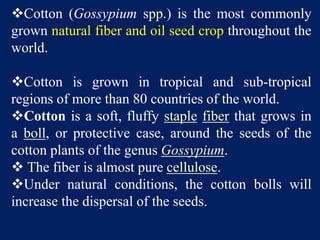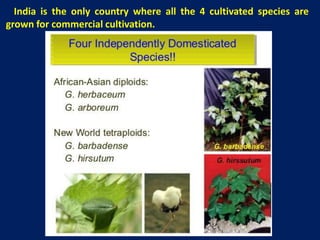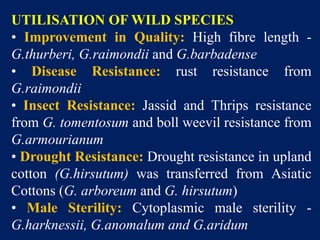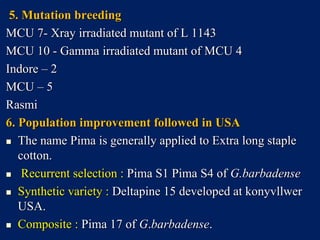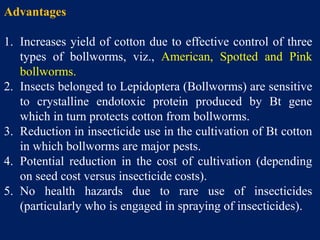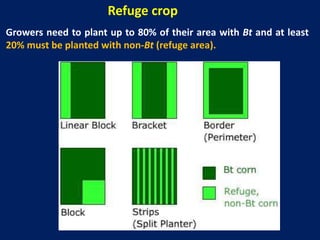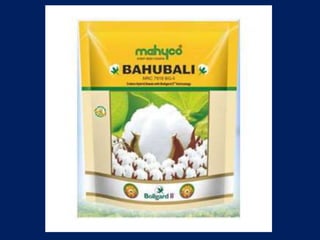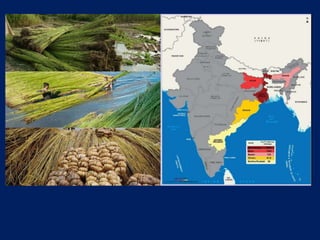cotton n jute
- 1. The UNO declared 2009 as “The Year of Natural Fibers.”
- 2. Year Designated by UN as 2020 The United Nations (UN) is declaring 2020 the ‘International Year of Plant Health.’ Capping off the ‘Decade on Biodiversity,’ the UN continues to recognize and promote healthy ecosystems as key to sustainable development. 2016 International Year of Pulses 2015 International Year of Soils 2010 International Year of Biodiversity 2009 International Year of Natural Fibres 2008 International Year of the Potato
- 3. List of vegetable fibers Vegetable fibers are generally based on arrangements of cellulose, often with lignin.
- 4. Fibres – Cotton and Jute The UNO declared 2009 as “The Year of Natural Fibers.”
- 5. Cotton (Gossypium sps) (2n = 2x = 26 2n = 4x = 52) Family : Malvaceae
- 7. Cotton (Gossypium spp.) is the most commonly grown natural fiber and oil seed crop throughout the world. Cotton is grown in tropical and sub-tropical regions of more than 80 countries of the world. Cotton is a soft, fluffy staple fiber that grows in a boll, or protective case, around the seeds of the cotton plants of the genus Gossypium. The fiber is almost pure cellulose. Under natural conditions, the cotton bolls will increase the dispersal of the seeds.
- 10. Origin: Central Africa Distribution: World: China, USA, India, Pakistan, Egypt. India: Rajasthan, Maharashtra, M.P. Gujarat, A.P. Karnataka and Tamil Nadu. Progenitors: Gossypium africanum G. raimondii Gossypium africanum – reached India by traders and travelers and differentiated into two species G. herbaceum and G. arboreum
- 11. Global distribution of Gossypium (cotton) cultivation
- 14. Sr.NoBotanical Name Chromosome No Genome Remarks 1 G.herbaceum 2n=26 A1A1 Deshi or old world cotton 2 G.arboreum 2n=26 A2A2 Deshi or old world cotton 3 G.hirsutum ( upland or American cotton) 2n=52 A1A1D1D1 American or new world cotton 4 G.barbadense ( Egyptian or Peruvian cotton) 2n=52 A2A2D2D2 American or new world cotton SPECIES : Cotton belongs to genus Gossypium. The genus has 35 diploid (ABCDEFG genomes) and 7 tetraploid species out of these only two diploid and two tetraploid species are categorized as cultivated.
- 18. India is the only country where all the 4 cultivated species are grown for commercial cultivation.
- 21. Cultivated Species: I. Asiatic cottons or old world cotton (Diploid cotton – 2n = 26) G. arboreum – G. herbaceum – II. New world cotton (Tetraploid cottons – 2n = 52) G. hirsutum – American / upland cotton G. barbadense – Egyption / sea island cotton G. hirsutum is predominant species which contributes about 90% to the current world production.
- 22. Cotton species Cotton fiber type Length Properties Gossypium hirsutum Short-staple (SS) cotton fiber up to 1.125 inches long not as high- quality as other forms of this textile fiber Gossypium barbadense Extra-long- staple (ELS) between 1.125 and 1.25 inches long consists of longer cotton fibers that produce softer and more luxurious textiles Cotton Plant Varieties
- 24. UTILISATION OF WILD SPECIES • Improvement in Quality: High fibre length - G.thurberi, G.raimondii and G.barbadense • Disease Resistance: rust resistance from G.raimondii • Insect Resistance: Jassid and Thrips resistance from G. tomentosum and boll weevil resistance from G.armourianum • Drought Resistance: Drought resistance in upland cotton (G.hirsutum) was transferred from Asiatic Cottons (G. arboreum and G. hirsutum) • Male Sterility: Cytoplasmic male sterility - G.harknessii, G.anomalum and G.aridum
- 26. Breeding objectives 1. High yield (more bolls, bigger bolls and high lint percentage) Lint % = weight of fibre / weight of cotton Lint index = 100 seed weight X lint % / 100– lint %
- 27. Early maturity Superior fibre quality A.Fibre length Superior, long fibre -27mm or more Long fibre - 24.5 - 26 mm Superior, medium long - 22 - 24 mm Medium long - 20 – 21.5 mm Small fibre - 19mm or less B. Fibre strength C. Fibre fitness Better plant type- – less spreading and dwarf plants are preferred Resistance to diseases -Seedling rot , Fusarium wilt, Verticillium wilt, Bacterial light Resistance to insects - Cotton boll worms, Spotted worm, Jassids and thrips, White fly, Aphid Resistance to abiotic stresses.
- 28. Breeding Methods: Cotton is often cross pollinated- heterozygosity for many alleles becomes a chief feature of the varieties developed as improved populations. The varieties developed through strict pureline breeding are devoid of the desired level of heterozygosity and are consequently less vigorous and low yielder.
- 29. Breeding Procedures 1. Introduction : Cambodia cotton in South India, MCU- 1 2. Selection : K1 cotton reselection from SRT -1 3. Hybridization and selection a) Inter varietal : MCU 5 - Multiple cross derivative MCU 6 - Multiple cross derivative MCU 9 - (MCU 5 x MCU 8) MCU 11 - (MCU 5 x Egyptian hirsutum)
- 30. b) Inter specific hybridization: Origin of New World Cotton G. herbaceum Var africanum linted X G. rarimondii lintless Old world cotton American cotton Diploid (2n=2x=26) Diploid (2n=2x=26) AA DD F1 hybrid Diploid 2n=2x=26 AD Sterile Doubling of chromosomes G. hirsutum New world cotton Amphidiploid 2n = 4x = 52 AA DD
- 31. 4. Heterosis breeding India is the first country in the world to release first commercial hybrid in cotton. C.T. Patel was mainly responsible for the hyrid cotton revolution in India. Hybrid 4, the first commercial hybrid, was released by him I 1970. It had the parentage of G 67 and American Nectariless. India was the first country to commercially cultivate intra- hirsutum hybrid. Both intraspecific and interspecific hybrids are evolved in cotton. a) Intraspecific : G.hirsutum x G.hirsutum Shankar (H4) cotton of Surat (Gujarat 67 x American nectariless) b) Interspecific hybrids : Varalakshmi (Laxmi x SB 289E) (G.hirsutum) x (G.barbadense) Using cytoplasmic genetic male sterility can also produce the hybrid. The first public bred hybrid released for commercial seed production is PKV HY 3 followed by PKV HY 4.
- 32. 5. Mutation breeding MCU 7- Xray irradiated mutant of L 1143 MCU 10 - Gamma irradiated mutant of MCU 4 Indore – 2 MCU – 5 Rasmi 6. Population improvement followed in USA The name Pima is generally applied to Extra long staple cotton. Recurrent selection : Pima S1 Pima S4 of G.barbadense Synthetic variety : Deltapine 15 developed at konyvllwer USA. Composite : Pima 17 of G.barbadense.
- 33. 7. Genetic Engineering (Biotechnology) Has helped in developing transgenic Bt cotton with resistance to Helicoverpa. The resistant gene (Cry1Ac) has been transferred from bacteria Bascillus thuringiensis into cotton plant by Monsanto Seed Company in U.S.A. The crystal (cry) gene types encode insecticidal crystal proteins (ICPs) that are specific to Lepidoptera (cry1), Diptera and Lepidoptera (cry2), Coleoptera (cry3), Diptera (cry4), or Coleoptera and Lepidoptera (cry5). The gene coding for Bt toxin has been inserted into cotton as a transgene, causing it to produce this natural insecticide in its tissues.
- 35. Bt cotton, as GM cotton is known, is the only commercialized GM crop in India. Mahyco-Monsanto Biotech Ltd introduced its first-generation Bt cotton, called Bollgard I (BG-I) in 2002 and Bollgard II (BG-II) in 2006. Bollgard II contains two Bacillus thuringiensis genes Cry1Ac and Cry2Ab which both control certain Lepidopteran larvae when they feed on it. Cry1Ac is specific to Lepidoptera (moths, including our major pests, Helicoverpaspp.) and Cry2Ab to Diptera (flies) and Lepidoptera, giving inbuilt protection against the larvae of Helicoverpa spp. India has bred Bt-cotton varieties such as Bikaneri Nerma and hybrids such as NHH-44. Punjab Agricultural University(PAU) has successfully developed the country’s first Bt cotton varieties. ICAR has identified three varieties, namely PAU Bt 1, F1861 and RS 2013, for cultivation in Punjab, Haryana, Rajasthan. It is a cheaper alternative to Bt cotton hybrid seed.
- 37. Advantages 1. Increases yield of cotton due to effective control of three types of bollworms, viz., American, Spotted and Pink bollworms. 2. Insects belonged to Lepidoptera (Bollworms) are sensitive to crystalline endotoxic protein produced by Bt gene which in turn protects cotton from bollworms. 3. Reduction in insecticide use in the cultivation of Bt cotton in which bollworms are major pests. 4. Potential reduction in the cost of cultivation (depending on seed cost versus insecticide costs). 5. No health hazards due to rare use of insecticides (particularly who is engaged in spraying of insecticides).
- 38. Refuge crop Growers need to plant up to 80% of their area with Bt and at least 20% must be planted with non-Bt (refuge area).
- 40. Disadvantages 1. High cost of Bt cotton seeds as compared to non Bt cotton seeds. 2. Effectiveness up to 120 days, after that the toxin producing efficiency of the Bt gene drastically reduces. 3. Ineffective against sucking pests like jassids, aphids, whitefly etc.
- 41. CICR developed simple ‘dip-stick’ kits and ‘ELISA’ (Enzyme Linked Immuno-Sorbent Assay)
- 42. Hybrids: Interspecific hybrids- Varalakshmi, HB 224 Intraspecific hybrids- Dhanalaxmi, H4, H6 Desi cotton - DH 7, DH9 Male sterility based hybrids- Suguna, PKVHY3, ARDH- 7 Varieties: MCU – 5, MCU – 10, K9, K10
- 44. It takes one pound of chemical fertilizers and pesticides to conventionally grow the three pounds of cotton needed to make a T-shirt and a pair of jeans.
- 45. ECO-FRIENDLY COTTON Cotton cultivated without using fertilizers pesticides and other chemicals (organic farming) Residue of these chemicals removed during first two seasons of cultivation Cotton from third season onwards is eco- friendly Indentified by logos Organic cotton Green cotton Natural cotton
- 46. Organic cotton in India Five to seven decades ago, most of the cotton cultivated in the country was ‘eco-friendly’ with little or no use of toxic chemicals in its production. Even today, there are many pockets in India, where it is produced without the use of agrochemicals, e.g., areas growing Wagad cotton in Gujarat, Y-1 desi cotton of Khandesh region of Maharashtra, Maljari in Madhya Pradesh, part of areas growing Jayadhar and Suyodhar in Karnataka. Nandigama in Andhra Pradesh and parts of cotton areas in north eastern hill region.
- 48. NATURALLY COLOURED COTTON Cotton that grows with natural colours during cultivation both white and coloured cottons known since time immemorial In India.
- 49. Breeding centers International Cotton Advisory Committee (ICAC), Washington, D.C., United States ICCC – Indian Central Cotton Committee -1921 Central Institute of Cotton Research (CICR) Nagpur All India Coordinated Cotton Improvement Project (AICCIP), Coimbatore CIRCOT - Central Institute for Research on Cotton Technology, Mumbai - 1924
- 50. Family: Malvaceae (formerly under Tiliaceae) (2n=14)
- 52. Jute is known as the ‘Golden Fibre’ due to its golden brown colour and its importance. Jute is the cheapest and the second most important vegetable fibre following cotton in terms of global production, consumption, and availability. Jute fibre is 100% biodegradable and recyclable and thus, environment friendly. It is one of the most versatile natural fibres that has been in use as raw material for packaging, textiles, non-textiles, construction, and agricultural sectors. It helps to make best quality industrial yarn, fabric, net, and sacks. In the era of growing awareness about environmental pollution and ecological degradation due to synthetic polymers, the importance of natural fibre like jute is gaining momentum.
- 54. The genus Corchorus includes about 87 species. In India only 8 species occur. Two cultivated species are C.capsularis : White jute 50 races occur in this C.olitorius : Tossa jute 8 races occur in this. Both the species are not crossable.
- 55. White jute Tossa jute C.capsularis C.olitorius Fibre is white in colour Fibre is golden in colour Yields less fibre/unit area Yields more fibre/unit area Fibre is course, less lustrous and more rooty Fiber is finer, softer, more, lustrous and less rooty Not grown much in India Accounts 75% of the total land area under jute cultivation Does not easily adapt to harsh climatic conditions Hardy and highly adaptable Can be grown only on lowlands Grows well on both lowlands and uplands Single flush of flowering Pre mature flowering is the major draw back Differences between White jute and Tossa jute
- 56. Corchorus olitorius (Tossa Jute) Corchorus capsularis (White Jute)
- 57. White jute (C.capsularis) Tossa jute (C.olitorius )
- 60. Distribution pattern of wild species of Corchorus in Africa, Australia, South America, Caribbean Island, and Indian subcontinent The primary center of origin and diversity of the wild taxa of Corchorus appears to be Africa
- 61. Representative wild species of Corchorus including available Indian species Representative wild species of Corchorus including available Indian species (a) Corchorus aestuans, (b) Corchorus depressus, (c) Corchorus fascicularis, (d) Corchorus pseudocapsularis, (e) Corchorus pseudo-olitorius, (f) Corchorus tridens, (g) Corchorus trilocularis, (h) Corchorus urticifolius, (i) Corchorus cunnighamii, (j) Corchorus hirsutus, (k) Corchorus sedoides, (l) Corchorus walcottii
- 63. Breeding objectives 1. Breeding for high yielding short duration jute varieties. Early varieties are generally low yielders whereas late varieties are high yielders. So to combine high yield with earliness is one of the main objectives. Yield is positively correlated with plant height, basal diameter of stem, fibre-stick ratio. Higher photo synthetic capacity with increased lamina length, breadth, petiole length and leaf angle at 40O also contribute to yield.
- 64. 2. Breeding for quality fibre In jute quality is negatively, correlated with yield. The quality characters are a) Fibre length. b) Fibre strength c) Fibre colour d) Lustre e) Percentage and quality of retting
- 65. Retting is a process in which the tied bundles of jute stalks are taken to the tank by which fibres get loosened and separated from the woody stalk. The bundles are steeped in water at least 60 cm to 100 cm depth.
- 67. 3. Breeding for pest and disease resistant varieties In pests, stem borer and aphids cause greater damage and in diseases Macrophomena is major. Though resistance sources are available in other related species, the crossability barrier prevents transfer. 4. Breeding varieties for high seed yield : Since jute is cut for fibre at 50% flowering stage, it is essential to reserve some plants for production of seeds. The fibre obtained from seed crop will be poor in quality. Hence it is necessary to breed varieties specially for high seed production without loosing quality characters.
- 68. 5. Breeding for olitorius varieties having non- shattering habit coupled with non-pre flowering habit. JRO 524 JRO 7885 Sudan green x JRO 632
- 69. Breeding Methods 1. Germplasm building and Utilization Central Jute Technological Research Institute, Calcutta is maintaining the Jute collections. This shows wide range of variability thus offering a great scope for improvement by selection and hybridsation. 2. Introduction : Introduced short duration varieties are Jap green, Jap red, Jaichung sudan green.
- 70. 3. Hybridization and selection a) Inter-varietal: Multiple crossing and selection are followed both in olitorius and capsularis improvement. In olitorius improved varieties are JRO 524, JRO 7885. In capsularis JRL 412, JRL 919 Since yield and quality are negatively correlated a balance must be struck in breeding for improved varieties.
- 71. b) Inter-specific cross: So far not successful. Attempts were made by straight cross mixed pollen method, Stigmatic paste method, self anther paste method, stigma cut method polyploidy breeding. But none of them proved successful. Difference in embryo endosperm growth is the reason. 4. Mutation breeding : Using X-rays useful jute mutants were obtained at Calcutta JRC 7447 and Rupali two varieties.
- 73. The International Jute Organization (IJO), Dhaka, Bangladesh Central Research Institute for Jute and Allied Fibers (CRIJAF), Barrackpore, West Bengal NIRJAFT - National Institute of Research on Jute and Allied Fibre Technology, Kolkata, West Bengal NINFET- National Institute of Natural Fibre Engineering and Technology, Kolkata







